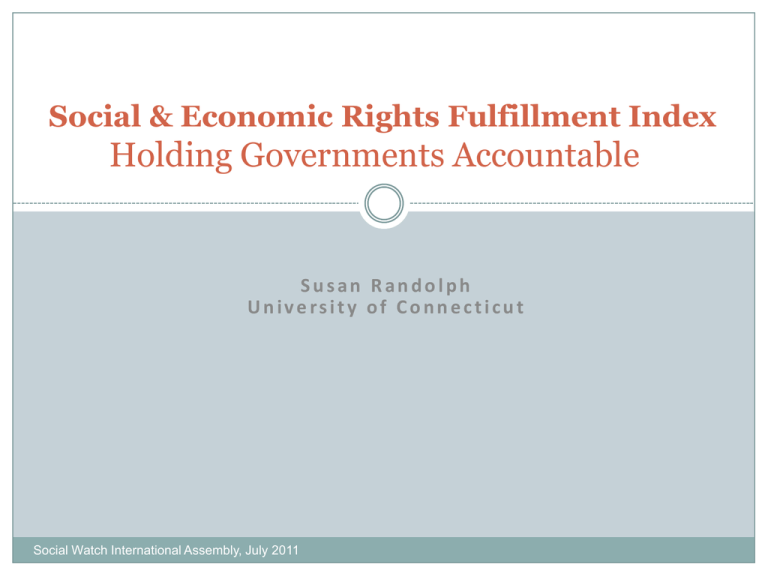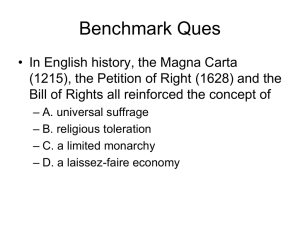
Social & Economic Rights Fulfillment Index
Holding Governments Accountable
Susan Randolph
University of Connecticut
Social Watch International Assembly, July 2011
The Economic & Social Rights
Empowerment Initiative
www.serfindex.org
Social Watch International Assembly, July 2011
The SERF Index Approach
SERF Index Methodology
Core & High Income Country SERF Index
Historical SERF Index
Application to the USA
Social Watch International Assembly, July 2011
The SERF Index Methodology
Social Watch International Assembly, July 2011
General Approach
Principle of progressive realizationcountries
commit maximum of available resources to fulfill
economic and social rights.
Zi = right enjoyment level / state obligation level
Socio-economic indicators assess enjoyment
Achievement Possibility Frontiers assess state capacity
Social Watch International Assembly, July 2011
Measuring Rights Enjoyment
For each substantive right
the right to food,
right to adequate shelter,
right to health care,
right to education,
Right to decent work,
right to social security.
Identify socio-economic indicators reflecting
relevant aspects of right
Objective survey based data
Social Watch International Assembly, July 2011
Achievement Possibilities Frontiers
APF for Primary School Completion Rate
Social Watch International Assembly, July 2011
Frontier Shapes and
Plateau per capita GDP Level Differ
Social Watch International Assembly, July 2011
Construction of the SERF Index
Indicator 1
Indicator 2
APF 1
APF 2
Indicator
Performance
Score 1
Average
Indicator
Performance
Score 2
Weighted Average of Right Indices
Social Watch International Assembly, July 2011
Right
Index
SERF Index
Core & High Income Country
SERF Indices
Social Watch International Assembly, July 2011
Indicators of Rights Enjoyment Level by Right
Social/Economic Right
Indicator for Core SERF Index
Indicator for High Income OECD Country SERF
Index
Right to Food
% children (0-5) NOT Malnourished (height for age)
%Infants NOT low birth weight
Right to Education
Primary school completion rate;
Combined school enrollment rate;
Combined school enrollment rate
Average math and science PISA score
Child Survival Rate (%);
Child Survival Rate (%);
Age 65 Survival Rate (%);
Age 65 Survival Rate (%)
Right to Health
Contraceptive Use Rate
Right to Adequate Housing
Access to improved water source (% rural population);
(incorporates Right to Water)
Access to improved sanitation (% total population)
Right to decent work
% NOT absolutely poor (> $2 a day (2005 PPP);
Data not available.
% NOT relatively poor (> 50% median income);
% not long term unemployment (% employed;
Right to social security
Data not available
Social Watch International Assembly, July 2011
Data not available
Mean Score on SERF Index
Social Watch International Assembly, July 2011
Core SERF Index
SCORE ON INDEX (%)
90-100
75-89.9
50-74.9
25-49.9
0-24.9
10 countries
45 countries
37 countries
7 countries
1 country
Uruguay, Jordan, Belarus,
Moldova, Kyrgyz Republic,
Cuba, Ukraine, Chile, Serbia
Jamaica, Guyana, Bulgaria,
Argentina, Brazil, Georgia,
Kazakhstan, Tunisia,
Malaysia,
Thailand, Armenia,
Russian Federation, Albania,
Iran, Mexico, Turkey,
Romania, Dominican
Republic,
Sri Lanka, Paraguay,
Macedonia, Ecuador, Liberia,
Algeria, The Gambia,
Belize, Nicaragua,
Egypt, Venezuela,
El Salvador, Tajikistan,
China, Colombia, Vietnam,
Uzbekistan,
Trinidad and Tobago,
Mongolia, Philippines,
Suriname, Morocco,
Honduras, Togo,
Azerbaijan, Peru,
Dem. Rep. of Congo
Social Watch International Assembly, July 2011
Malawi, Burundi, Timor-Leste, Republic of Congo,
Equatorial Guinea
Bolivia, Ghana, Kenya,
Madagascar, Tanzania,
Rwanda, Nepal, Comoros,
Burkina Faso, Nigeria, Chad,
Guatemala, Indonesia,
Angola
Bangladesh, Senegal,
Sierra Leone, Mozambique,
Mauritania, Lesotho,
Botswana, Guinea-Bissau,
Cambodia, Bhutan, Namibia,
Ethiopia, Cameroon, Pakistan,
Zambia, India, Cote d'Ivoire,
Djibouti, Lao PDR, Mali,
Guinea, Benin, Yemen, Niger,
Swaziland, Gabon
OECD High Income Country SERF Index
SCORE ON INDEX (%)
90-100
5 countries
80-89.9
13 countries
Finland, Sweden,
Republic of Korea,
Norway,
Denmark
Canada, Netherlands,
Australia, Poland,
Austria, France,
Czech Republic,
Switzerland, Spain,
Hungary,
United Kingdom,
Ireland, Belgium
Social Watch International Assembly, July 2011
<80
6 countries
United States, Slovak
Republic, Italy, Greece,
Belgium, Luxembourg
Same SERF different HDI
Social Watch International Assembly, July 2011
Historical SERF Index
WITH
PATRICK GUYER
Social Watch International Assembly, July 2011
Historical
SERF Index
Addresses
Two Aspects
of
Progressive
Realization
At any given time, is a country
fulfilling its economic and social
rights obligations of result to the
maximum of its available
resources?
Over time, is the extent to which a
country’s citizens and residents
enjoy their ESR increasing in
relation to the potential given the
growth in its available resources?
Social Watch International Assembly, July 2011
Indicators of Rights Enjoyment Level by Right
Social/Economic Right
Indicator for Core Historical SERF Index
Indicator for High Income OECD Country
Historical SERF Index
Right to Food
% Children (0-5) NOT Malnourished (height for age)
%Infants NOT low birth weight
Right to Education
Primary school completion rate;
Gross secondary school enrollment rate;
Gross secondary school enrollment rate
Right to Health
% child (under 5) survival rate;
% child (under 5) survival rate;
Life Expectancy at Birth;
Life Expectancy at Birth
Contraceptive Use Rate
Right to Adequate Housing
Access to improved water source (% rural
(incorporates Right to Water)
population);
Right to decent work
% Not Absolutely poor ($2 a day 2005 PPP)
Data not available.
% Not Relatively poor (< 50% median income);
% Not Long term unemployment (% unemployed;
Social Watch International Assembly, July 2011
Historical SERF Index
Four Waves
Wave 1: 1971-1980
Wave 2: 1981 – 1990
Wave 3: 1991-2000
Wave 4: 2001 – 2010
Results
Trends in average performance
Variation in performance
Relationship between ESR fulfillment & per capita income growth
Social Watch International Assembly, July 2011
Core
Historical
SERF
Trends in Average
Performance
Social Watch International Assembly, July 2011
Core Education Index Trends
Social Watch International Assembly, July 2011
Core Health Index Trends
Social Watch International Assembly, July 2011
Core Food Index Trends
Social Watch International Assembly, July 2011
Core Housing Index Trends
Social Watch International Assembly, July 2011
Core Work Index Trends
Social Watch International Assembly, July 2011
Core SERF Trends
Social Watch International Assembly, July 2011
High Income
OECD Country
SERF
Trends in Average
Performance
Social Watch International Assembly, July 2011
Wave 3 Origins to Wave 4 Destinations
Below Median GDP
Growth
Above Median GDP
Growth
SERF Lopsided
Virtuous
Above Median
SERF
31%
25%
46%
Below Median
SERF
Vicious
67%
Social Watch International Assembly, July 2011
68%
6
%
17
%
6
%
44%
6
%
Growth Lopsided8
%
15
%
44%
17
%
Application to the United States
WITH
MICHELLE PRAIRIE
&
JOHN STEWART
Social Watch International Assembly, July 2011
Indicators of Rights Enjoyment Level by Right:
International and State Versions
Social/Economic Right
International
US States
(High Income OECD countries)
Right to Food
%Infants NOT low birth weight
%Food secure
Right to Education
Combined school enrollment rate
Net secondary school enrollment rate;
Average math and science score (PISA)
4th and 8th grade, average math and reading NAEP scores
Child Survival Rate (%);
Child Survival Rate (%);
Survival to Age 65 (%)
Life Expectancy
Right to Health
% Infants with normal birth weight
Right to Decent Work
% unemployed unemployed < 12 months;
100% -Youth (20-24) unemployment rate;
% with > 50% median income
100% - involuntary part-time employment rate;
% with > 50% median income
Right to Adequate Housing
Data not Available
% renters spending < than 30% income on housing
% School children not homeless
Right to Social Security
Data not available
% with Health Insurance
% NOT Absolutely poor (US Standard)
Right to Equality and Nondiscrimination
Social Watch International Assembly, July 2011
Data disaggregated by sex and racial/ethnic group
ESRF Value by State
80-84.9%: 15 states
North Dakota, Wyoming,
Montana, South Dakota, Idaho,
New Hampshire, West Virginia,
Nebraska, Maine, Vermont,
Wisconsin, Iowa, Minnesota,
Hawaii, Kansas
75-79.9%: 22 states
70-74.9%: 11 states
North Carolina, Colorado, Nevada,
Mississippi, New Mexico, Arizona,
Delaware, Alaska, Texas, Oregon, New
York,
65-69.9%: 2 states
California, Louisiana
Social Watch International Assembly, July 2011
Social Watch International Assembly, July 2011
Right Component Index Ranges
Right
Index
Range
# States
>90%
# States
<75%
Mean
Standard
Deviation
Food
68.1-86^
0
20
76.4
3.67
Education
85.2-97.7%
41
0
92.6
3.05
Health
85.9-94.2%
37
0
91.2
2.11
Decent Work
62.7-79.5%
0
39
71.6
4.01
0
49
46.7
12.48
2
86.1
4.1
Decent Housing 11.2%-79.1%
Social Security
75.2%-92.1% 9
Social Watch International Assembly, July 2011
Incorporating Discrimination
Could not incorporate all rights given data
limitations
omit right to food & right to decent housing.
Sex discrimination:
Right to health: only indicator available is child survival rate
Racial/ethnic discrimination:
Right to health: omits life expectancy
Right to education: only indicator available NAEP score
Right to work: omits youth unemployment
Social Watch International Assembly, July 2011
Taking Discrimination Into Account
Correct Indicator Value for Discrimination
xD = (1-w) SPixi + wx1
XD is the indicator value corrected for discrimination
Xi is the value of the indicator for subgroup i
i is an index for sub-group with i=1 assigned to the sub-group with the lowest
score on the indicator
Pi is the proportion of the population in sub-group i
The value selected for w determines the emphasis placed on non-
discrimination.
If w = 1 then the value of the indicator index equals the value of the indicator
for the subgroup with the lowest score.
If w = 0 then there is no penalty for discrimination.
Social Watch International Assembly, July 2011
Sex Discrimination
(ω=1)
Overall, obligations are met to same extent for males
and females.
21 states females marginalized, 29 states males marginalized
Difference never as great as 1%
Average hides differences in aspects of rights
fulfillment
Social Watch International Assembly, July 2011
Sex Discrimination
Education:
boys marginalized,
difference 3-4% reflecting quality dimension
Health: boys marginalized but difference < 1%
Work:
women marginalized on decent wage aspect,
but men marginalized on access dimension;
in both cases diff 10% so overall only minor differences.
Social Security: overall no difference but
Men marginalized access health insurance by 5%
Women marginalized absolute poverty by 5%
Social Watch International Assembly, July 2011
Racial/Ethnic Discrimination
Consider here 3-way classification:
white, black, Hispanic
Aggregate Results:
Pervasive violation right to non-discrimination.
US seriously delinquent in its duty to respect, protect, & promote the
economic and social rights of black Americans in particular.
SERF index value adjusted for race/ethnic discrimination on
average falls 10%
Variation across states: California only falls 3%, Wisconsin &
Missouri nearly 20%.
Reflects substantial differences in value of indicators by ethnic
group within any state
Social Watch International Assembly, July 2011
Racial/Ethnic Discrimination: Education
Fulfillment of right to education differs dramatically
across ethnic groups
Great divide: whites & Asians vs. others
Marginalized group is blacks in most states, but Hispanics fare
worst in 8 states.
Change in Education index value
17 points on average
Range -6% (New Mexico) to -30% (Wisconsin)
Social Watch International Assembly, July 2011
Racial/Ethnic Discrimination: Health
Differences in fulfillment of right to health not as
marked as for right to education, but still substantial
Blacks the marginalized group in all states
Typically disadvantage is 8-10%, but varies from -4.9 in
Hawaii to -12.6 in Wisconsin.
Disadvantage of blacks is greatest on normal birth weight
index (Hispanics fare best)
Social Watch International Assembly, July 2011
Racial/Ethnic Discrimination: Decent Work
This is the rights dimension that decreases the most
upon incorporating non-discrimination
Average decrease is 20%
Fell by between 35% & 45% in Iowa, Missouri and Washington
State
Great divide is between whites & all others
Differences in marginalized group across dimensions
Decent pay: Blacks most marginalized
Security and work environment: Hispanics fare worst
Social Watch International Assembly, July 2011
Racial/Ethnic Discrimination: Social Security
This rights dimension decreases nearly as much, just
under 20%, upon incorporating non-discrimination.
Variation across states -12.2% (California) to -33.9 (Delaware)
Hispanics fare worst
Hispanic disadvantage most strongly related to lack of health
insurance
Absolute poverty disadvantage (post transfers) not as great as
that for health insurance.
Social Watch International Assembly, July 2011
THANK YOU
Social Watch International Assembly, July 2011
EXTRA SLIDES
Social Watch International Assembly, July 2011
Wave 3 Origins to Wave 4 Destinations
Above Median
SERF
Below Median
SERF
Below Median GDP
Growth
Above Median GDP Growth
SERF Lopsided
Virtuous
16 W3 countries had W4 status of:
68.8% Virtuous
25.0% SERF lopsided
6.3% Vicious
0.0% Growth Lopsided
Vicious
13 W3 countries had W4 status of:
66.7% Vicious
16.7% SERF lopsided
16.7% Growth Lopsided
0.0% Virtuous
Social Watch International Assembly, July 2011
13 W3 countries had W4 status of:
46.2% Virtuous
30.8% SERF lopsided
15.4% Vicious
7.7% Growth Lopsided
Growth Lopsided
16 W3 countries had W4 status of:
43.8% Growth Lopsided
43.8% Vicious
6.3% SERF lopsided
6.3% Virtuous
Core Countries
Average % Gain
by decade
1975-85
1985-95
19952005
Health
23.3
6.3
4.7
Education
42.7
20.2
21.8
Food
20.9
1.9
3.8
Housing
22.9
10.5
2.8
Work
-
-1.7
5.3
SERF
-
4.5
8.9
Social Watch International Assembly, July 2011
High Income
OECD
Countries
1975-85
1985-95
19952005
Health
2.8
2.2
2.4
Education
29.5
21.5
2.6
Food
1.5
0.8
-1.5
Work
-16.8
-8.2
5.4
SERF
3.6
2.8
2.1
Average % gain by
decade
Social Watch International Assembly, July 2011
Formula F
Adjustments for
Observed Achievements
of 40, 60, 80, 90, and
95% at Income Ratios
Up to 10.
Social Watch International Assembly, July 2011
Adjustment for Countries Capable of Fulfilling Right
If Y>Yp, the per capita income
level where it is feasible to achieve
100% on possibilities frontier (see
graph)
And the country’s achievement on
the indicator is less than 100%,
Then x% is adjusted: a penalty is
subtracted from the achieved index
value so that:
100
Frontier=100%
x
% Achievement
on Rights
Indicator
50
0
0
GNP per capita
yp
Social Watch International Assembly, July 2011
y
X* = (x% - penalty)/100%
The penalty increases by factor
related to Yp as per capita
income increases







